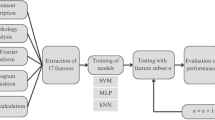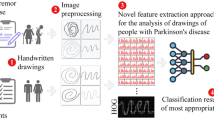Abstract
In this paper, a method for diagnosing Parkinson’s disease based on features derived from hand-drawn spirals is presented. During drawing of these spirals on a tablet, coordinates of points of the spiral, pressure and angle of the pen at that point, and timestamp were registered. A set of features derived from the registered data, by means of which the classification was performed, has been proposed. For testing purposes, classification has been done by means of several of the most popular machine learning methods, for which the accuracy of Parkinson’s disease recognition was determined. The study has proven that the proposed set of features enables the effective diagnosis of Parkinson’s disease. The proposed method can be used in screening tests for Parkinson’s disease.
The experiments were conducted on a publicly available “Parkinson Disease Spiral Drawings Using Digitized Graphics Tablet Data Set” database from the UCI archives. This database contains drawings of spirals made by people with Parkinson’s disease as well as by healthy people.
Access this chapter
Tax calculation will be finalised at checkout
Purchases are for personal use only
Similar content being viewed by others
References
Golbe, L.I., Mark, M.H., Sage, J.I.: Parkinson’s Disease Handbook. The American Parkinson Disease Association Inc. (2010)
Parkinson, J.: An Essay on the Shaking Palsy. London (1817)
Grosset, D., Fernandez, H., Grosset, K., Okun, M.: Parkinson’s Disease Clinician’s Desk Reference. CRC Press, Boca Raton (2009)
Isenkul, M.E., Sakar, B.E., Kursun, O.: Improved spiral test using digitized graphics tablet for monitoring Parkinson’s disease. In: The 2nd International Conference on e-Health and Telemedicine (ICEHTM-2014), pp. 171–175 (2014)
Erdogdu Sakar, B., et al.: Collection and analysis of a Parkinson speech dataset with multiple types of sound recordings. IEEE J. Biomed. Health Inform. 17(4), 828–834 (2013)
Froelich, W., Wrobel, K., Porwik, P.: Diagnosis of Parkinson’s disease using speech samples and threshold-based classification. J. Med. Imaging Health Inform. 5(6), 1358–1363 (2015)
Deisenroth, M.P., Turner, R.D., Huber, M.F., Hanebeck, U.D., Rasmussen, C.E.: Robust filtering and smoothing with Gaussian processes. IEEE Trans. Autom. Control 57(7), 1865–1871 (2012)
Ibrahim, M.Z., Mulvaney, D.J.: Geometrical-based lip-reading using template probabilistic multi-dimension dynamic time warping. J. Vis. Commun. Image Representation 30, 219–233 (2015)
Salvador, S., Chan, P.: Toward accurate dynamic time warping in linear time and space. Intell. Data Anal. 11(5), 561–580 (2007)
Muramatsu, D., Kondo, M., Sasaki, M., Tachibana, S., Matsumoto, T.: A Markov chain Monte Carlo algorithm for Bayesian dynamic signature verification. IEEE Trans. Inf. Forensics Secur. 1, 22–34 (2006)
Aha, David W.: Incremental constructive induction: an instance-based approach. In: Machine Learning Proceedings, pp. 117–121 (1991)
Quinlan, J.R.: C4. 5: Programs for Machine Learning. Elsevier, Amsterdam (2014)
Breiman, L.: Random forests. Mach. Learn. 1, 5–32 (2001)
Johnson, R.A., Bhattacharyya, G.K.: Statistics: Principles and Methods. Wiley, Hoboken (2019)
Rojas, R.: AdaBoost and the super bowl of classifiers a tutorial introduction to adaptive boosting (2009)
Wrobel, K.: Diagnosing Parkinson’s disease with the use of a reduced set of patients’ voice features samples. In: Saeed, K., Chaki, R., Janev, V. (eds.) CISIM 2019. LNCS, vol. 11703, pp. 84–95. Springer, Cham (2019). https://doi.org/10.1007/978-3-030-28957-7_8
Pudil, P., Novovicova, J., Kittler, J.: Floating search methods in feature selection. Pattern Recogn. Lett. 15(11), 1119–1125 (1994)
Porwik, P., Doroz, R.: Self-adaptive biometric classifier working on the reduced dataset. In: Polycarpou, M., de Carvalho, A.C.P.L.F., Pan, J.-S., Woźniak, M., Quintian, H., Corchado, E. (eds.) HAIS 2014. LNCS (LNAI), vol. 8480, pp. 377–388. Springer, Cham (2014). https://doi.org/10.1007/978-3-319-07617-1_34
Betkowska Cavalcante, A., Grajzer, M.: Proof-of-concept evaluation of the mobile and personal speech assistant for the recognition of disordered speech. Int. J. Adv. Intell. Syst. 9, 589–599 (2016)
http://mpass.gidolabs.eu. Accessed 20 May 2022
Kamble, M., Shrivastava, P., Jain, M.: Digitized spiral drawing classification for Parkinson’s disease diagnosis. Meas. Sens. 16, 100047 (2021)
Parisi, L., Neagu, D., Ma, R., Campean, F.: Quantum ReLU activation for convolutional neural networks to improve diagnosis of Parkinson’s disease and COVID-19. Expert Syst. Appl. 187, 115892 (2022)
Nõmm, S., Zarembo, S., Medijainen, K., Taba, P., Toomela, A.: Deep CNN based classification of the archimedes spiral drawing tests to support diagnostics of the Parkinson’s disease. IFAC-PapersOnLine 53(5), 260–264 (2020)
Chakraborty, S., Aich, S., Sim, J.-S., Han, E., Park, J., Kim, H. C.: Parkinson’s disease detection from spiral and wave drawings using convolutional neural networks: a multistage classifier approach. In: 22nd International Conference on Advanced Communication Technology (ICACT), pp. 298–303 (2020)
Author information
Authors and Affiliations
Corresponding author
Editor information
Editors and Affiliations
Rights and permissions
Copyright information
© 2022 The Author(s), under exclusive license to Springer Nature Switzerland AG
About this paper
Cite this paper
Wrobel, K., Doroz, R., Porwik, P., Orczyk, T., Cavalcante, A.B., Grajzer, M. (2022). Features of Hand-Drawn Spirals for Recognition of Parkinson’s Disease. In: Nguyen, N.T., Tran, T.K., Tukayev, U., Hong, TP., Trawiński, B., Szczerbicki, E. (eds) Intelligent Information and Database Systems. ACIIDS 2022. Lecture Notes in Computer Science(), vol 13758. Springer, Cham. https://doi.org/10.1007/978-3-031-21967-2_37
Download citation
DOI: https://doi.org/10.1007/978-3-031-21967-2_37
Published:
Publisher Name: Springer, Cham
Print ISBN: 978-3-031-21966-5
Online ISBN: 978-3-031-21967-2
eBook Packages: Computer ScienceComputer Science (R0)




